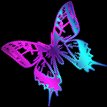|
Introduction to the Holidays
SABBAT -- any one of the eight seasonal festivals equally spaced throughout the year.
ESBAT -- any one of the 13 lunar festivals throughout the year, celebrated at the times of the full moon.
The major holidays are called Sabbats. These holidays fall into two groups: Quarter and Cross Quarter Holidays. Quarter holidays are those which fall in the wheel in the 12:00, 3:00, 6:00, and 9:00 positions, Cross Quarters are those holidays which fall between the quarter holidays.
Quarter holidays are: Winter Solstice; Spring Equinox; Summer Solstice; Fall Equinox.
The Cross Quarter holidays are: Samhain, Imbolc, Bealtaine, and Lughnasadh.
Above, at the top of the page, you can see the Wheel of the Year which is similar to a calendar. Most practitioners believe each year is a cycle that will repeat itself eternally thus we have the circle with each quarter and cross-quarter as the "spokes" of the wheel. At the Winter Solstice (Dec21) the God is born to the Goddess. Throughout the year, the God and Goddess change. The God matures while the Goddess goes through the three moon cycle phases of the Maiden, Mother, Crone. Then at Samhain (Oct31-Nov2), the God dies and the Goddess mourns his death in the darkness before it all begins again once more returning to the rebirth at Winter Solstice. The cycle is everlasting. Below is a very brief summary of each individual holiday and then a more in depth explanation follows.
(Cónacht is the word for Equinox)& (Grianstad is the word for Solstice) (The solstices and equinoxes were called Albans)
Imbolc (February 2): Imbolg, (pronounced "IM-bulk" or "EM-bowlk"), also called Oimealg, ("IM-mol'g), is the festival of the lactating sheep. It is derived from the Gaelic word "oimelc" which means "ewes milk". Herd animals have either given birth to the first offspring of the year by this time or their wombs are swollen and ready. (Imbolc/Im-bolg comes from the gaelic word meaning "in the belly".) It is said that the Goddess begins recovery from giving birth. She is resting and preparing for rejuvenation. The God is in his childhood. The holiday is also called 'Brighid's Day', in honor of the great Irish Goddess Brighid, who was known as the goddess of fire, smithcraft, poetry and healing. This Feast is sacred to the Lady, the child-woman, the virgin who is known as Brighid. She becomes a bride on this day. She is awaiting the return of the young Sun God, who is soon to return to her.
Meán Earrach/Spring: (Spring Equinox) (Alban Eiler, Light of the Earth): The Goddess warms the Earth and the God is now growing into a young man . Other deities now struggle in the underworld, but will soon return from the Land of the Dead.
Bealtaine (April 30 - May 1): Also called May Eve. Beltane marks the emergence of the young God into manhood.
The God and Goddess fall in love and she takes him as her consort. She then becomes pregnant. This is not looked upon as incest any more than with Adam and Eve's children having to marry and create life. This is primarily a fertility festival.
Spring is in full bloom.
Meán Samhraidh/Summer: Midsummer (Summer Solstice)(Alban Heruin, The Light of the Shore) : Nature is now at it's peak and it is officially the first day of summer. It is also referred to as Midsummer because it is approximately the middle of the growing season throughout much of Europe.
Magick abounds throughout the lands. We now celebrate the impending fatherhood of the Sun God, as the Goddess is round with child and in full health. We also celebrate abundance, warmth, and fertility, and the feminine aspect. This is a perfect time to get involved in anything having to do with art and show it at the celebration. It is also a good time for magickal workings of all kinds. Considered a day sacred to the sidhe.
There was a fire festival on this night and also love magic. It was said that maidens would find out about their future husband. Another role of these bonfires was to generate sympathetic magic, giving a boost to the energy of the sun so that it would remain agreeable throughout the rest of the growing season and guarantee a plentiful harvest. Traditionally, herbs are gathered on this day and are said to be extrememly powerful. We take our ritual for a walk honor nature's spirits.
Lughnasadh (August 1): The first crops have been harvested. The God begins losing power. This is a celebration honoring the marriage of the God, Lugh, to the Mother. Lughnasadh symbolized the beginning of harvest, and the ending of Summer with Winter approaching. The first crops have now been harvested and the God begins losing power. This is a harvest celebration honoring the God, Lugh, and giving thanks for what we have been given. We mourning the harvest God’s passing.
The God is beginning to weaken, and the days are growing shorter.Lugh was a popular god associated with the harvest, as well as the Sun. God of All Skills, he was known as the "Bright or Shining One". There were games held during this time,in honor of the waning god. They were said to be funeral games for Lugh. Death and rebirth were a part of the cycle during Lugh's continuing journey.
He is associated with both the Sun and fertility of the harvests. Lughnasadh was originally started as a time to assemble to mourn the death of summer, and the death of the Corn God. The failure of the harvest
meant starvation and death for the people and a good harvest was essential to life and great cause for celebration. Bread was baked at this time and eaten and also shared with the earth. This is also a time for charity to those less fortunate and creativity.
Many also say that the Goddess oversaw the festival in her triple guise as Macha, her warrior aspect, at this time. She conveyed the deceased into the realm of death.
Meán Fómhair/Fall: Fall Equinox (Alban Elued, The Light of the Water): The God becomes weaker. The Goddess becomes weary and nature begins to enter into it's winter cycle. She is still pregnant at this time, and we honor her as the new mother. This is the second harvest festival and marks the end of harvest. This time honors the The Green Man and the God in his full maturity. It is celebrated by an offering of libations to trees.
Samhain (Halloween): The God death occurs, but he will be reborn to the Goddess once again upon the arrival of Yule. And the cycle begins once more.
This celebration is geared towards making contact with the spirits of departed ancestors. These spirits were believed to
be sources of guidance and inspiration. The old God dies to prepare for the rebirth of the child. It is symbolized by the Crone and her aged
Consort.
Meán Geimhreadh/Winter: (Winter Solstice) (Alban Arthuan, The Light of Arthur): The Sun God is soon to be born of the Goddess who is signified by the moon. We welcome back the light (the God).
Winter Solstice, or Alban Artuan as it was called in the Druid Tradition, meaning the Light of Arthur, is the time of death and rebirth. The ancestors awaited the rebirth of the child.
One of the most important things to understand about the eight Sabbats is that they are not man-made. By this, I mean that they are not holidays like Memorial Day or 4th of July. They do not commemorate any historical event. These holidays existed long before man himself and very well might be said to be as old as the Earth herself. These holidays are festivals of Nature. They follow the seasons... as the earth follows the seasons...we follow the seasons.
The four "Greater Sabbats" or "High Holidays" of the year bisect the quarters on the Wheel of the Year, falling at the mid-point of each. These are considered the cross-quarter-days. Their great antiquity was recently underscored by the discovery in Ireland of earthwork alignments of the sun's position on the horizon for each of the cross-quarter days. That means that the holiday we today call "Halloween" or "Samhain" has been celebrated as far back as megalithic times!
The Four Lesser Sabbats: are referred to as the "quarter-days", because they quarter the year. Most, not all, modern practitioners tend to call them the four "Lesser Sabbats" or "Low Holidays". These are the Winter and Summer Solstice, and the Spring and Vernal Equinox.
When the hours between sundown and sunup are the greatest and the night is the longest of the year, we call this the Winter Solstice. And exactly opposite on the wheel of the year, we have the longest day of the year, and the shortest night. And we call this the Summer Solstice.
There are two more festival days that are similar. Each Spring, there comes a day when the hours between sunrise and sunset are exactly equal to the hours between sunset and sunrise. And we call this the Vernal Equinox.
Likewise, there is a day each Fall when the hours of darkness and the hours of daylight are perfectly in balance. And this is called the Autumnal Equinox. No one made these holidays up. They are simply a part of nature's eternal cycle.
The oldest astronomical alignment of which we have a record points to the sun's position in the sky on the Winter Solstice. And this is on a burial mound in County Meath, Ireland. There are numerous sites, such as Stonehenge, that have clear alignments to the Summer Solstice, Winter Solstice, Vernal and Autumnal Equinoxes. These can be found the world over from the pyramids of ancient Egypt to the ancient temples of China and beyond.
The Esbats (lesser holidays) or Lunar Festivals (rituals focused on the phases of the moon) honor the journey of the Goddess through her individual phases across the seasons, much as our Sabbats honor the journey of the God throughout the solar year. The Olde and New traditions uniformly celebrate these at the Full Moon, but some traditions also celebrate lunar festivals at the New or Dark Moon as did the ancients. In most forms of the Occult religions, the holidays are celebrated primarily around the story of the Goddess, however we are reminded that all life is born from procreation through both the God and the Goddess.
Now here is where I would like to point something out that I have found to be vastly different than when I was learning as a child. In the days of olde, The Craft was performed without prejudice to either the male or female aspect of the creator. The Goddess and the God had equal footing. Within recent years, the population has somehow garnered that it is a religion mostly dedicated to the female. This is not true. Nothing could be further from truth than this, in fact. If our world was created with only one sex in mind, then we would have only God or only Goddess. In almost all life forms, both are necessary for creation. And both are necessary to keep our world in balance, and isn't that what this is all about?
More to follow on each individual holiday.
Back to the Holidays
| 







